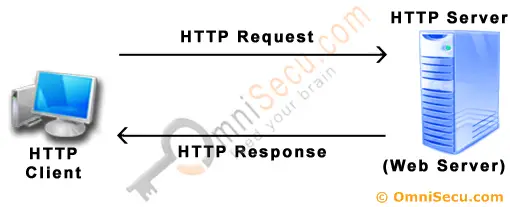Hypertext Transfer Protocol (HTTP) - Request and Response
The operation of Hypertext Transfer Protocol (HTTP) involves the communication between a Hypertext Transfer Protocol (HTTP) client application (Usually web browser) and a Hypertext Transfer Protocol (HTTP) server application (Web servers like IIS). Hypertext Transfer Protocol (HTTP) uses Transmission Control Protocol (TCP) as the Transport Layer Protocol at Well Known port number 80. Once the TCP connection is established, the two steps in Hypertext Transfer Protocol (HTTP) communication are
1) HTTP Client Request: Hypertext Transfer Protocol (HTTP) client sends an Hypertext Transfer Protocol (HTTP) Request to the Hypertext Transfer Protocol (HTTP) Server according to the HTTP standard, specifying the information the client like to retrieve from the Hypertext Transfer Protocol (HTTP) Server.
2) HTTP Server Response: Once the Hypertext Transfer Protocol (HTTP) Request arrived at the Hypertext Transfer Protocol (HTTP) server, it will process the request and creates an Hypertext Transfer Protocol (HTTP) Response message. The Hypertext Transfer Protocol (HTTP) response message may contain the resource the Hypertext Transfer Protocol (HTTP) Client requested or information why the Hypertext Transfer Protocol (HTTP) request failed.

Hypertext Transfer Protocol (HTTP) Request and Response.
Improvements in HTTP/1.1
Multiple Host Name Support: HTTP/1.1 supports specifying a Hostname in header. This allows running multiple websites using a single IP address helps preventing the depletion of IPv4 addresses. Any combination of IP address, Port number and Hostname can be used to identify a website.
Persistant Connections: In HTTP/0.9 and 1.0, the TCP connection is closed after a single HTTP Request/HTTP Response pair. In HTTP/1.1 a keep-alive-mechanism was introduced, where a TCP connection could be reused for more than one request. The defualt working principle of HTTP was not changed and the difference is that the TCP connection is kept open after each HTTP Request/HTTP Response pair. Persistent connections reduce delay remarkably, because the client does not need to re-negotiate the TCP connection if it want to retrieve any resource immediately.
Partial Resource Selection: In HTTP/1.1 the client can request for a partial resource. This feature can reduce the workload of the server and save the available bandwidth.
You have learned how Hypertext Transfer Protocol (HTTP) client and server communicates, HTTP Request/Respose pair, Improvements in HTTP/1.1 and what is a Hypertext Transfer Protocol (HTTP) keepalive. Click "Next" to continue.